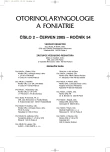-
Medical journals
- Career
Reliability of SSEP Method in the Examination of Hearing in Young Children
Authors: P. Myška; M. Jurovčík; Z. Kabelka; E. Vymlátilová; J. Štěpánek 1
Authors‘ workplace: Foniatrické oddělení a Centrum kochleárních implantací u dětí Klinika ušní, nosní a krční 2. LF UK a FN Motol, Praha přednosta doc. MUDr. Z. Kabelka Zvukové studie HAMU, Praha ; vedoucí studia prof. Ing. V. Syrový, CSc. 1
Published in: Otorinolaryngol Foniatr, 54, 2005, No. 2, pp. 82-86.
Category: Original Article
Overview
Summary:
The study presents the comparisons of results of two examinations of hearing carried out in young children by means of the Steady State Evoked Potentials (SSEP) method with the interval of several months. The SSEP method has been applied at our clinic since July 1999. Its main advantage is the frequency specificity. Patients are examined at the frequencies of 0.5, 1, 2 and 4 kHz. The study comprised 64 children, of whom 45 were later implanted. The results of the study indicate a high correlation of threshold values in the two examinatinos carried out by means of SSEP method and thus confirm its reliability.Key words:
SSEP – Steady State Evoked Potentials, reliability.
Labels
Audiology Paediatric ENT ENT (Otorhinolaryngology)
Article was published inOtorhinolaryngology and Phoniatrics

2005 Issue 2-
All articles in this issue
- Surgical Complications in the Group of 206 Children Users of Cochlear Implants
- Prediction of Benefit from Cochlear Implantation by Means of ChIP (Children’s Implant Profile)
- Reliability of SSEP Method in the Examination of Hearing in Young Children
- Short-term and Long-term Functional Results of Stapedoplasty
- Reflex Response of the Stapes Muscle Induced by Acoustic Stimulation: Systematic Arrangement of Conditions for the Induction
- Serum Levels of Growth Factors HGF (Hepatocyte Growth Factor) and TGFβ1 (Transforming Growth Factor) in Parathyroid and Thyroid Tumors
- Experience in Vestibular Habituation Training in the Therapy of Balance Disorders
- Surgical Treatment of Lower Concha Hypertrophy by Means of Microdebrider
- Otorhinolaryngology and Phoniatrics
- Journal archive
- Current issue
- Online only
- About the journal
Most read in this issue- Surgical Treatment of Lower Concha Hypertrophy by Means of Microdebrider
- Reflex Response of the Stapes Muscle Induced by Acoustic Stimulation: Systematic Arrangement of Conditions for the Induction
- Short-term and Long-term Functional Results of Stapedoplasty
- Experience in Vestibular Habituation Training in the Therapy of Balance Disorders
Login#ADS_BOTTOM_SCRIPTS#Forgotten passwordEnter the email address that you registered with. We will send you instructions on how to set a new password.
- Career

